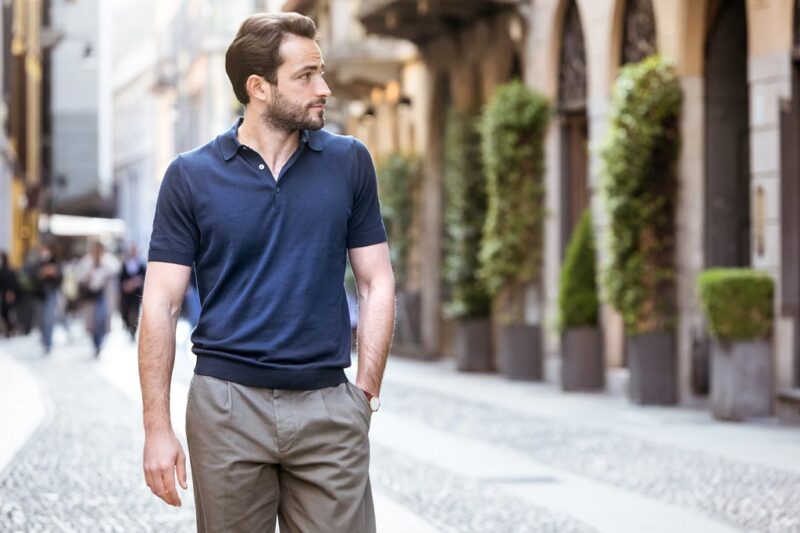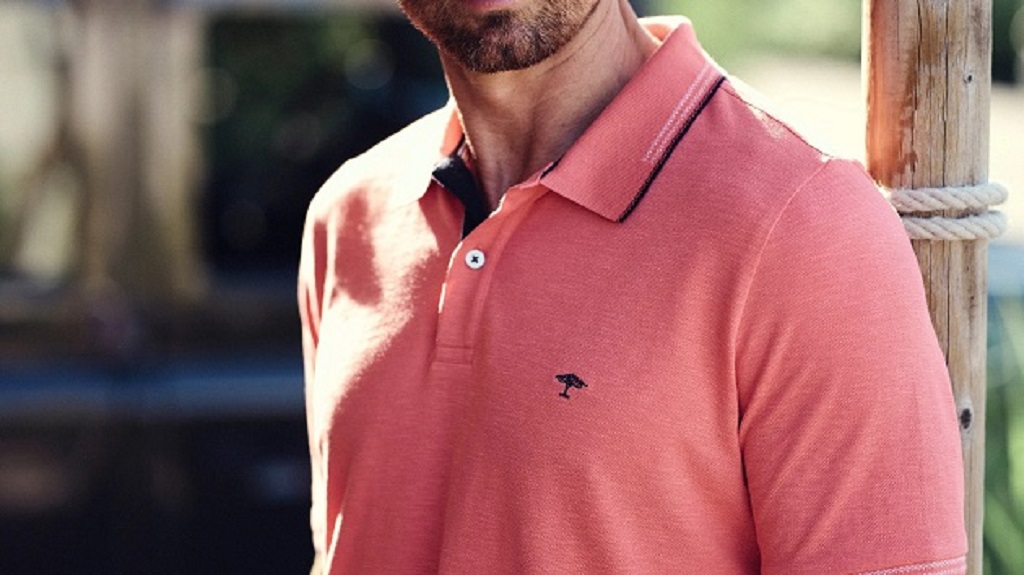The polo shirt has gained immense popularity in American and global fashion culture as a go-to attire for casual occasions. Its unique blend of a button-down design and a collared neckline offers a subtle touch of formality, which sets it apart from a basic t-shirt. At the same time, the polo shirt retains its signature relaxed and comfortable vibe, making it a versatile wardrobe essential for the modern-day fashionista. But an important question arises: Can the polo shirt be integrated into casual business dress codes? Is a polo shirt business simple? Or is it too simple for professional work environments?
A Brief History of the Polo Shirt
To understand the role of the polo shirt today, it helps to look at its origins.
The polo shirt emerged in the late 19th century as a practical garment for polo, tennis, and golf. Polo players wore long-sleeved shirts made of knitted cotton, ideal for allowing athletic movement. These early “tennis shirts” featured a placket with 2 or 3 buttons at the neckline for extra durability.
In the 1920s, French tennis star Rene Lacoste began selling a version of the shirt with a softer collar, shorter sleeves, and signature crocodile logo embroidery. This iconic “polo shirt” developed an association with upper-class leisure and became a pillar of casual menswear in the mid-20th century.
Meanwhile, American brands like Brooks Brothers and Lacoste offered stylish takes on the polo for women. The relaxed sensibility and breathable fabric made polos famous for casual occasions and country club attire.
By the 1950s and 60s, preppy stylings and widespread adoption in sports helped cement the polo shirt’s reputation as the epitome of casual cool. But could such a laidback garment cross over into professional settings as well?
The Rise of Business Casual Attire
Alongside the polo’s popularity, the business attire culture began shifting in a more relaxed direction in the late 20th century.
As far back as the 1950s and 60s, some companies experimented with “casual Fridays” to boost employee morale. However, the concept of business casual as an everyday approach didn’t spread until the 1980s and ’90s.
Increasingly competitive workplaces decided to allow more casual wear to foster creativity and authenticity among employees. Dockers, khakis, knit tops, and other comfortable pieces became acceptable for day-to-day office wear.
This business casual revolution opened the door for the polo shirt in professional settings. There was a garment that had already struck the right balance – polished but approachable, neat yet laid back.
How Fashion Experts Classify the Polo Shirt
With business casual on the rise, how do style authorities view the polo shirt’s level of formality today?
Most fashion experts agree that polo shirts qualify as business casual apparel in modern work environments. But they offer some caveats.
For instance, celebrity stylist George Brescia says polos hit the “sweet spot” between casual everyday wear and formal attire. But he notes some styles and fabrics are more polished than others.
Men’s fashion writer James Brundage acknowledges the polo shirt has an innate country club vibe. However, he says minimalist designs without puffed sleeves or distracting logos can elevate the garment’s formality.
And according to celebrity stylist Amanda Sanders, polos offer an intelligent yet approachable look for casual offices. But she suggests dressing them up with tailored trousers or pencil skirts to “go corporate casual.”
So, consensus indicates the polo shirt can be appropriate for business casual. But the overall style and context make a big difference.
Factors That Impact Formality
When deciding if a polo shirt is dressy enough for the office, here are some factors to consider:
Fabric
- Pique cotton – The classic polo shirt fabric has a knit texture that’s casual by nature. Best for more laidback office environments.
- Jersey – Silkier, smoother jersey polos can look dressier than pique cotton ones.
- Performance fabrics – Technical fabrics like moisture-wicking polyester are ideal for sports but too casual for business wear.
Style
- Trim fit – A tailored, slim-cut polo looks sharper than an oversized, boxy one.
- Minimal details – Avoid fancy embroidery, loud patterns, or contrast color collars. Simple is best.
- Collar style – A polo with a neat point collar projects more polish than a floppy open collar.
- Length – Going untucked is acceptable for casual settings, but keep polos tucked in for business.
Color
- Neutral tones – Monochromatic black, gray, white, or navy polos are safest.
- Pastels – Softer light blue or pink hues can work for creative fields.
- Bright colors – Vibrant orange, lime green, and other bold shades are better for weekends.
Pairing
- Full suit – A polo shirt under a blazer and formal trousers elevate the overall look.
- Dress pants – For women, pairing a polo with a pencil skirt instantly “dresses up” the outfit.
- Nice denim – Dark wash designer jeans can bridge the formality gap if jeans are typically permitted.
- Footwear – Finish off a business casual polo outfit with leather shoes or clean sneakers.
Paying attention to these factors makes it easier to incorporate polo shirts into business casual dress codes. But the vibe of the individual workplace is vital.
Polo Shirts in Different Office Environments
While polos may be business casual material objectively, are they always acceptable in actual professional settings? Here’s a rundown of how polo shirts tend to fly in common office cultures:
Corporate Offices
In traditionally buttoned-up corporate jobs like banking, law, and finance, polo shirts are generally too casual for client meetings. Employees may be able to wear them on days without external face time. Polos pair nicely under a blazer for an effortless, smart-casual vibe at corporate offices.
Startups & Tech Companies
The dress code barometer skews casual at Silicon Valley giants and other innovation-driven firms. Employees at these technology or creative startups usually feel free to wear polo shirts in the office daily. However, some may prefer tees and hoodies!
Business Casual Offices
Polos are fair game for everyday wear in professional services, media, or other business casual work cultures. But it’s still wise to sometimes mix in collared dress shirts and blouses. Save embellished polos for the golf course.
Remote Work Environments
The polo shirt lets employees feel casually put together on video calls when working from home. But beware of getting too comfortable! It may be wise to change out of polos before online meetings with external clients.
The expectations around formality vary quite a bit across different industries and organizations. The most important thing is understanding the norms and customs of your unique workplace environment.
Who Can Pull Off the Polo at Work?
From older executives to young interns, polo shirts at the office can work for all types of employees. But there are some situational factors to keep in mind:
Leadership Roles
For managers, directors, and other leaders, donning a polished polo helps show you are approachable and modern, not stuffy or out of touch. Just avoid overly casual fabrics or distracting designs.
Client-Facing Positions
Employees who meet with clients, investors, vendors, or other external partners should aim for polo shirts on the dressier end of the spectrum. Add a blazer or dress pants to project professionalism.
Creative Jobs
Artists, designers, tech engineers, and others in creative roles often have the flexibility to wear casual attire. The polo shirt can be a go-to for self-expression and comfort for these employees.
Internships
I expect to follow the office dress code norms as a young intern. If employees commonly wear polos, do likewise by picking simple, muted styles to come across as mature.
No matter your position or industry, approach polo shirt selection carefully. Seek guidance from managers if you are unsure whether your chosen styles hit the target level of formality.
Tips for Elevating Polo Outfits
Looking to blend polos into business casual attire seamlessly? Employ these simple tips:
- Prioritize minimalist solid color or striped polos in dark, neutral hues over bright or busy patterns.
- Seek polo shirts with wrinkle-resistant jersey fabric rather than cotton pique for a sharper look.
- Layer polo shirts under an unstructured sport coat or knit blazer to channel a stylish vibe.
- Tuck polos neatly into pleated trousers, pencil skirts, or crisp chinos to instantly dial the formality.
FAQs
FAQ 1: Are logo polo shirts acceptable for the office?
Logo polos are generally too casual for business wear. Stick to solid color or minimal stripe designs without any prominent branding.
FAQ 2: Should I tuck or untuck polo shirts at work?
For a polished business casual look, keeping polos tucked into pants or skirts is best. Untucked can appear sloppy.
FAQ 3: What should women pair with polo shirts for the office?
Pencil skirts, trousers, or midi skirts balance nicely with a women’s polo shirt for work. Add ballet flats, loafers, or low-block heels.
FAQ 4: Can I wear a polo shirt alone without a blazer or sweater?
You can wear a better polo shirt in more laid-back offices. But layers help elevate polos for business contexts.
FAQ 5: Is a polo shirt and jeans acceptable business casual attire?
Dark wash denim and a polo shirt can work for some creative offices but not for client meetings. Add dressier shoes and accessories.
Conclusion
The classic polo shirt can successfully straddle the line between casual weekends and professional business wear. With attention to fabric, fit, and pairing, men and women can incorporate polos into office-appropriate business casual outfits. Take cues from your workplace environment and tweak styles to meet formality expectations. Embarking on a journey into the world of Etsy business? Explore the best Etsy business ideas for newbies and discover a realm of possibilities. Just like the polo shirt, with the versatility to look sharp or laidback, these business ventures offer a modern yet timeless choice for those looking to craft a pulled-together and successful presence in the online marketplace.



